| View previous topic :: View next topic |
| Author |
Message |
Elise

Joined: 22 Dec 2009
Posts: 243
Location: New York State



|
 Posted: Sep 18, 2010 08:51 Post subject: Image of cyclic twinning in chrysoberyl Posted: Sep 18, 2010 08:51 Post subject: Image of cyclic twinning in chrysoberyl |
|
|
This is an inquiry on the behalf of a researcher here at Cornell University: does anyone know where one might obtain a nice photograph of cyclic twinning in chrysoberyl which can be used in an upcoming publication of a scientific paper (in nanotechnology). The authors were referred to us, hoping they could find a copyright free image or one which they might use with proper attribution in their paper. From his inquiry: " We are in the final turns of writing this paper where we've been able to stabilize these 6-fold nanoparticles in a high yield (greater than 90% have this symmetry). They look very much like a cyclic twin since they have orthorhombic unit cells, and that makes it a pretty interesting find. I didn't know twinning could be controlled en masse and for nanoparticles. Bill was helping us determine that it is a cyclic twin. Now we'd like to amplify this point by putting a picture of a chrysoberyl cyclic twin into our paper. Do you know of any resources for this? Or do you have any images of a chrysoberyl cyclic twin that we could use? We'd be very grateful." After looking through Wikipedia and Creative Commons, I thought maybe there might be a FMF member with knowledge of an educational resource or that had a portrait which they might think fun to connect to such a project.
Best wishes,
Elise
_________________
Elise Skalwold |
|
| Back to top |
|
 |
chris
Site Admin

Joined: 12 Jul 2007
Posts: 538
Location: Grenoble



|
 Posted: Sep 18, 2010 10:55 Post subject: Re: Image of cyclic twinning in chrysoberyl Posted: Sep 18, 2010 10:55 Post subject: Re: Image of cyclic twinning in chrysoberyl |
|
|
Hello Elise,
Don't know if it will help, but did you try the ESRF (www(dot)esrf(dot)eu/AboutUs/CompanyInfo/UsefulNumbers). It has a large collection of X-Ray diffraction pictures. Maybe one of them is from what you are looking for ?
Christophe
|
|
| Back to top |
|
 |
Jordi Fabre
Overall coordinator of the Forum

Joined: 07 Aug 2006
Posts: 5098
Location: Barcelona



|
 Posted: Sep 18, 2010 11:12 Post subject: Re: Image of cyclic twinning in chrysoberyl Posted: Sep 18, 2010 11:12 Post subject: Re: Image of cyclic twinning in chrysoberyl |
|
|
Hi Elise, I believe they look for a macro image not a nano image?
If correct, I can suggest to you the image below.
| Description: |
Twinned Chrysoberyl from Folch collection
About 8 x 8 cm.
Espirito Santo - Brazil
Photo. Carme Gimeno |
|
| Viewed: |
23437 Time(s) |
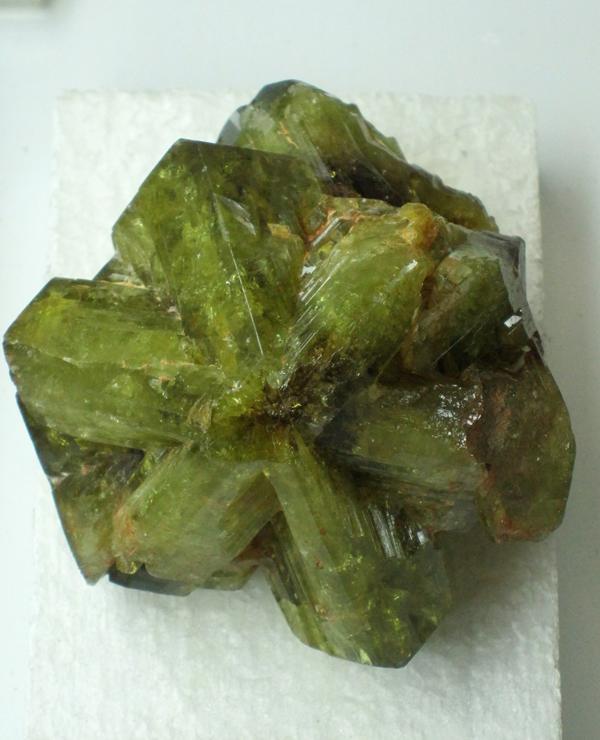
|
|
|
| Back to top |
|
 |
Elise

Joined: 22 Dec 2009
Posts: 243
Location: New York State



|
 Posted: Sep 18, 2010 11:24 Post subject: Re: Image of cyclic twinning in chrysoberyl Posted: Sep 18, 2010 11:24 Post subject: Re: Image of cyclic twinning in chrysoberyl |
|
|
Yes, sorry I should have said a macro image of a nice specimen. This would be for publishing in a journal and probably also for using in any associated powerpoint presentation on the study, so would have to have permission from the owner of the image. The image above looks like a likely candidate. Is this yours Jordi or can I put him in contact with you regarding its use? Maybe if there are several pictures suggested, I can direct him to this thread and he can see what best suits the need. Thank you so much for the quick replies! Elise
_________________
Elise Skalwold |
|
| Back to top |
|
 |
Jordi Fabre
Overall coordinator of the Forum

Joined: 07 Aug 2006
Posts: 5098
Location: Barcelona



|
 Posted: Sep 18, 2010 12:01 Post subject: Re: Image of cyclic twinning in chrysoberyl Posted: Sep 18, 2010 12:01 Post subject: Re: Image of cyclic twinning in chrysoberyl |
|
|
| Elise wrote: | | Is this yours Jordi or can I put him in contact with you regarding its use? |
No problems for the use Elise, just credit: Image from Carme Gimeno - https://www.foro-minerales.com
On case they would need the high resolution image then please contact with me.
I add another pic.
| Description: |
Twinned Chrysoberyl
Lac Alaotra, Alaotra-Mangoro, Tamatave, Madagascar
Former Silvane collection
Specimen size: 4.1 × 2.8 × 0.5 cm.
Photo from "Reference Specimens" |
|
| Viewed: |
23442 Time(s) |
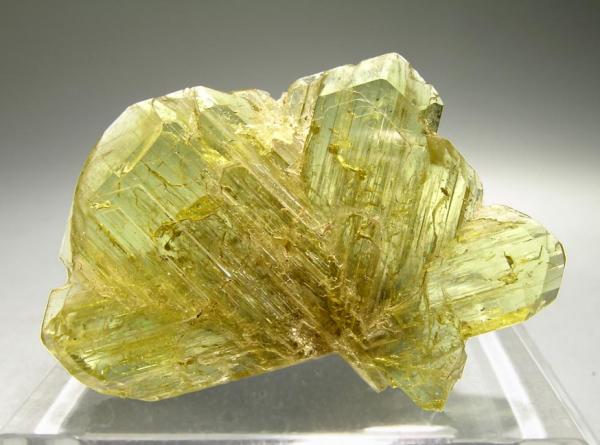
|
|
|
| Back to top |
|
 |
Pete Richards
Site Admin

Joined: 29 Dec 2008
Posts: 846
Location: Northeast Ohio



|
 Posted: Sep 18, 2010 16:33 Post subject: Re: Image of cyclic twinning in chrysoberyl Posted: Sep 18, 2010 16:33 Post subject: Re: Image of cyclic twinning in chrysoberyl |
|
|
Why are the authors fixed on chrysoberyl? Why not aragonite, or many other orthorhombic minerals that make pseudo-hexagonal twins? But certainly chrysoberyl is a very pretty example!
There's only a hint of the content in this thread, but I am suspicious of hypotheses which involve bringing discrete (even nano) particles together as a mechanism of forming twins. I'd be interested to see the paper....
_________________
Collecting and studying crystals with interesting habits, twinning, and epitaxy |
|
| Back to top |
|
 |
RichRobinson
Joined: 18 Sep 2010
Posts: 2
Location: Ithaca, NY


|
 Posted: Sep 18, 2010 20:06 Post subject: Re: Image of cyclic twinning in chrysoberyl Posted: Sep 18, 2010 20:06 Post subject: Re: Image of cyclic twinning in chrysoberyl |
|
|
Thank you for your comments and for the nice picture. Such a helpful and speedy community you are!
I am posting a picture I sent to Bill Bassett of our crystals. The material is Co2P. It has an orthorhombic unit cell. Under the right conditions we can get a full batch of particles to form these 6-fold symmetry stars. The Dark Field images (DF) in the figure are electron microscope diffraction images. They show that opposite arms have the same orientation. You can also see how the structures retain a 60 degrees spacing even when they have less than 6 arms.
In response to Pete we don't think this is agglomeration of nanoparticles but the twins form during nucleation. In the lower figure titled "Aliquots" you see a time series of the particles. Their seeds form the star shapes.
These facts led us to believe it was a cyclic twin that was causing the symmetry.
Cool parts: I don't know of a nanoparticle synthesis that has ever produced a >90% yield of six-fold symmetry particles. Does this happen in nature? If you find one cyclic twin chrysoberyl are all the other chrysoberyl around it also cyclic twinned since they were formed under the same conditions?
And how and under what conditions would all nuclei choose to produce the same twin?
All this is new to me.
thanks!
richard (the cornell person)
| Description: |
|
| Viewed: |
23387 Time(s) |
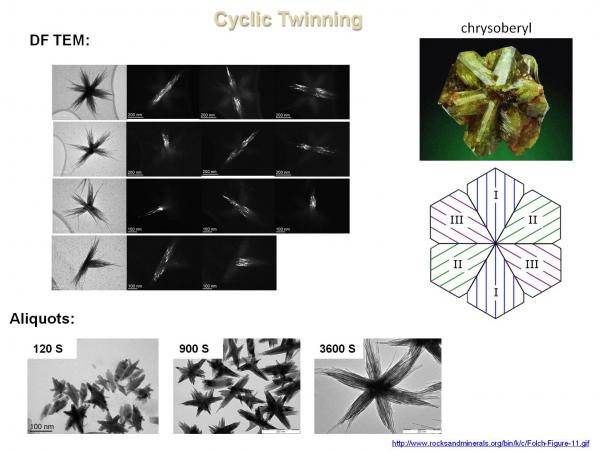
|
|
|
| Back to top |
|
 |
Pete Richards
Site Admin

Joined: 29 Dec 2008
Posts: 846
Location: Northeast Ohio



|
 Posted: Sep 19, 2010 14:54 Post subject: Re: Image of cyclic twinning in chrysoberyl Posted: Sep 19, 2010 14:54 Post subject: Re: Image of cyclic twinning in chrysoberyl |
|
|
Yes, I think twinning during nucleation is much more likely....
As for "always twinning", I'm not sure about chrysoberyl, but it seems to me that if some are cyclic twins, at least most of them are cyclic twins. Aragonite from certain locations always forms cyclic twins (saying "always" always makes me nervous...). Epididymite (orthorhombic) and eudidymite (monoclinic) from some occurrences at Mont Saint-Hilaire are always cyclic twins. I think there are other examples as well.
Why this is so is less clear. Twins may be able to grow faster in certain environments than untwinned crystals, and the latter may not survive the very early stages of growth, when re-dissolution can easily occur. A useful discussion of the energetics of twin formation, and other aspects of twinning, can be found in Sunagawa, Ichiro, 2005, Crystals: Growth, Morphology, and Perfection, Cambridge Press, pp. 128-137.
_________________
Collecting and studying crystals with interesting habits, twinning, and epitaxy |
|
| Back to top |
|
 |
Peter
Joined: 16 Jan 2009
Posts: 346
Location: Sweden / Luxembourg


|
 Posted: Sep 20, 2010 07:03 Post subject: Re: Image of cyclic twinning in chrysoberyl Posted: Sep 20, 2010 07:03 Post subject: Re: Image of cyclic twinning in chrysoberyl |
|
|
| Very interesting to get people from different fields in here Jordi. The Folch Chrysoberyl is MAGNIFICENT! Thanks for posting. Will need to come to Barcelona only for studying this collection.
|
|
| Back to top |
|
 |
RichRobinson
Joined: 18 Sep 2010
Posts: 2
Location: Ithaca, NY


|
 Posted: Mar 03, 2011 21:50 Post subject: Re: Image of cyclic twinning in chrysoberyl Posted: Mar 03, 2011 21:50 Post subject: Re: Image of cyclic twinning in chrysoberyl |
|
|
Thanks for the chrysoberyl images. our paper on cyclic twinning in now published. I am attaching the page with the picture.
The highlights of the paper are 1) we can form a “monodisperse” batch of anisotropic particles (>84% of the yield are six-armed particles. Instead of a motley bunch of anisotropic particles they all obey six-fold symmety. 2) we believe they nucleate from cyclic twins, which would make this a controlled method to produce identically twinned nuclei
DOI: 10.1021/nl103400a | Nano Lett. 2011, 11, 188–197
enjoy
richard
| Description: |
| Chrysoberyl picture featured from Joan Rosell from the page in the paper |
|
| Viewed: |
22271 Time(s) |
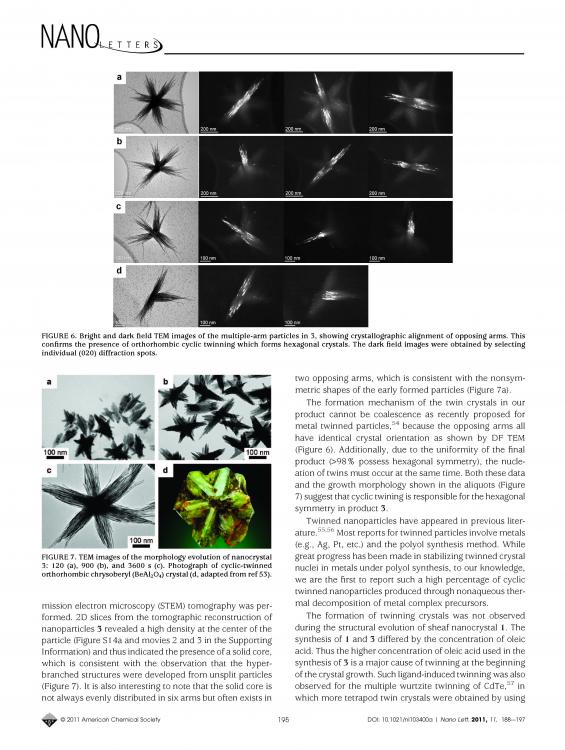
|
| Description: |
|
| Viewed: |
22292 Time(s) |
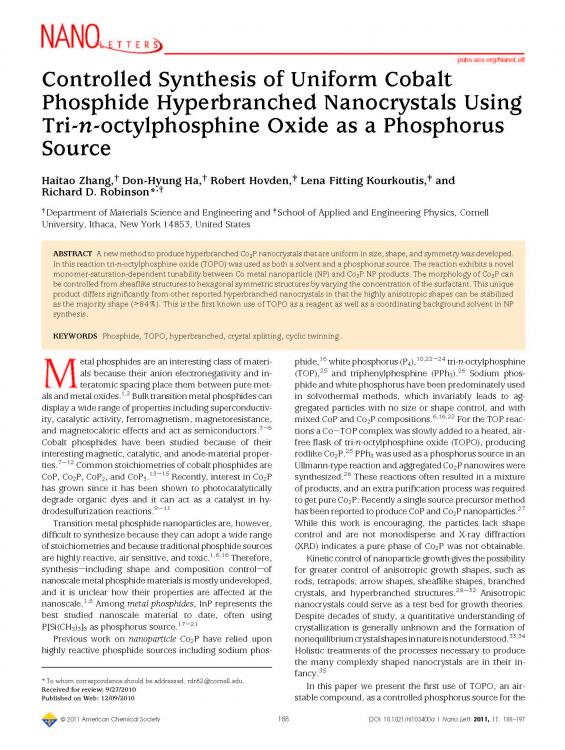
|
| Description: |
|
| Viewed: |
22326 Time(s) |
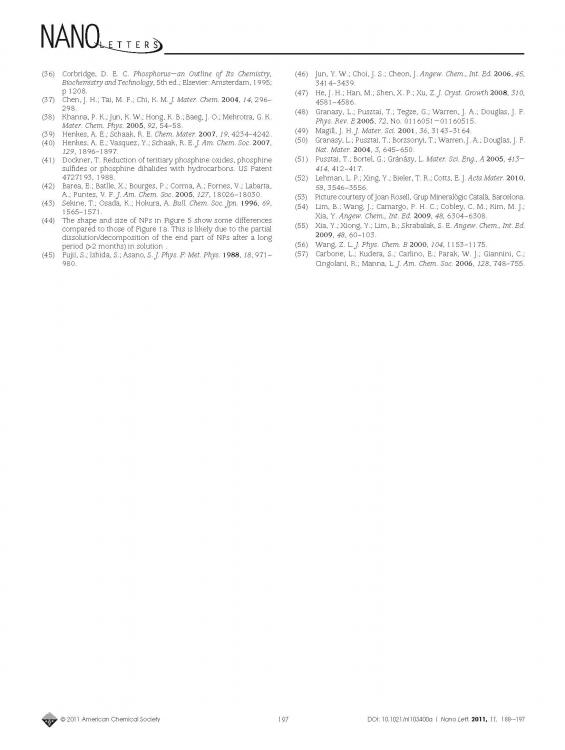
|
|
|
| Back to top |
|
 |
|




